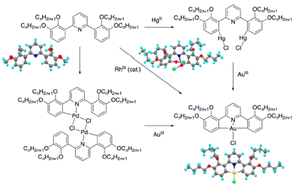Abstract
The C^N^C ligand 2,6-bis(2,3-dialkoxyphenyl)pyridine forms dimercury and orthopalladated complexes, both of which may be transmetallated to gold(III) complexes; the gold complexes may also be formed directly in a Rh(III)-catalysed process, hence it is possible to circumvent the use of organomercury intermediates in the synthesis of this important class of compound.



 Please wait while we load your content...
Please wait while we load your content...